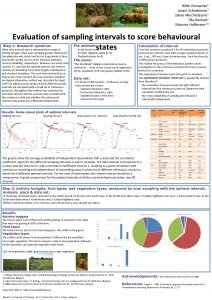Hilde Vervaecke 1 Joram Schatteman 2 1 Johan

- Slides: 1

Hilde Vervaecke 1 Joram Schatteman 2 1 Johan Miechielssens 1 Ella Roelant Maurice Hoffmann 2, 3 Evaluation of sampling intervals to score behavioural states Step 1: Research question: What time intervals give a representative image of activity budgets when scan-sampling grazers’ behaviour? Sampling intervals should not be too long (waste of time, inaccurate results) nor too short (reduced alertness, reduced reliability, dependence between successive data -points). To calculate the optimal interval, one method consists of calculating mean bout lengths of behaviours and standard deviations. The scan interval should be as long as the mean duration plus one standard deviation. An elegant alternative method was described by Engel (1997) in which pseudo-protocols with different sample intervals are compared with a small set of continuous protocols. We applied this method and evaluated for each interval how well the scanned data correlate with the continuous data and whether the subsequent scanned data points are sufficiently independent. The animals: Calculation of interval - Konik horses (n=5) - Scottish Highland cattle (n=4) - Shetland ponies (n=9) The place: “The Westhoek” Belgian coastal dune reserve, covered by : more or less closed scrub vegetation (41%), woodland (14%) and grassy habitat (45%). Data set: 127 focals of 900 seconds - continuous scoring Every second we scored: - ingestive behaviour state - locomotory behaviour state - vegetation types of the area - consumed food type From the continuous protocol a lot of instantaneous pseudoprotocols are derived, each with a longer sample interval (2 sec, 3 sec, … 900 sec), than its predecessor. Each focal results in 899 pseudo-protocols. The relative frequency of the behaviour pattern under investigation in the continuous protocol and every pseudoprotocol is computed. The dependence between each data point is calculated. The optimum sample interval is graphically derived from the plot of - the association of pseudo-protocols with different intervals and the continuous protocol (Spearman rank correlation coefficients) and - the mean probability of sampling the behaviour statistically independent. Results: Some visual plots of optimal intervals Walking (62 sec) Grazing (76 sec) Grass/wood mix (100 sec) Grass/herbs mix (90 sec) The graphs show the average probability of independent observations (left y-axis) and the correlation coefficient (right) for the different sampling intervals (x-axis in seconds). The ideal interval corresponds to a p-value that lies close to 0. 1 and a correlation coefficient close to 1, resulting in a good correlation with continuous recording and independence of succeeding scans. A whole lot of different behaviours result in a whole lot of different optimal intervals. For the ease of observation, the chosen interval should be a compromise. A good compromise for the optimal intervals of all the scored behavioural states, was 90 seconds. Variable Behaviour nr of focals Optimum used sample interval in seconds Probability Correlation at optimum locomotion lying 4 91 or 100 0. 088 1 - 0. 80 lying + ruminating 5 90 0. 095 1 walking 47 62 or 68 0. 042 – 0. 093 0. 86 – 0. 76 walking and grazing 77 76 1 0. 92 standing 63 78 or 79 0. 099 -0. 091 0. 89 -0. 92 standing + ruminating 4 100 0. 088 1 Ingestive drinking 11 41 0. 086 0. 92 grazing 77 73 or 75 0. 074 -0. 062 0. 96 -0. 92 Vegetation shrub with undergrowth 20 105 0. 098 0. 97 dune grassland 9 100 0. 059 0. 93 rough grassland 3 90 0. 625 1 shrub 2 woodland 4 98 0. 086 1 moss dune 2 moist rough vegetation 9 100 0. 087 0. 99 path 8 57 0. 060 0. 86 sparse vegetation 3 90 0. 062 1 food grass/woodmix 25 100 0. 088 0. 98 grass/herbmix 16 90 0. 072 0. 97 woody 10 50 or 52 0. 034 -0. 086 0. 93 -0. 82 short grass 52 81 0. 085 0. 98 herb/woodmix 4 100 0. 064 1 long grass 27 100 0. 088 0. 98 Step 2: Activity budgets, food types, and vegetation types, measured by scan sampling with the optimal interval: Animals, place & data set: 15 focals per individual were conducted in the North area & 25 focals in the South area. In the North area there were 3 Scottish Highland cows and 11 adult Konik horses; in the South area there were 5 Konik horses and 3 Scottish highland cows. Within focal observations of 15 minutes, every 90 seconds a scan sample was taken. Results Activity budgets The horses spent most of their time (62%) grazing, in contrast to the cattle that were not grazing in 69% of the time. Food types The horses fed on short (<5 cm) and long grass, the cattle on long grass. Vegetation types The cattle mostly stayed in dune grassland, followed by the woodland rough vegetation. The horses stayed mostly in dune grassland, followed by the woodland, and sparsely vegetated sand dunes. Konik horses activity budget Highland cattle activity budget Food types of Konik horses 70. 00% 60. 00% 50. 00% 40. 00% 30. 00% 20. 00% 10. 00% Berry Herb Leaves Long grasses Short grasses Food types of Highland cattle 90% Left: dune grassland, right: grassy dunes and rough vegetation. 80% Lying 70% Stand & graze Stand (not grazing) Walking Lying Stand & graze Stand (not grazing) Walking Trotting 60% 50% 40% 30% 20% 10% 0% Bush Herb 1: Odisee University College, Agro- and Biotechnology, Ethology and Animal Welfare, Hospitaalstraat 21, 9100 Sint-Niklaas, Belgium 2: Ghent University, Dept. of Biology, Terrestrial Ecology Unit, K. L. Ledeganckstraat 35, 9000 Gent, Belgium 3: INBO, Research Institute for Nature and Forest, Kliniekstraat 25, 1070 Brussels, Belgium Questions? Mail to: hilde. vervaecke@odisee. be Benelux Congress of Zoology, 12 -13 December 2014, Liège, Belgium. Leaves Long grasses Acknowledgements: References: We kindly thank Johan Lamaire of ANB. Engel, J. , 1996. Choosing an appropriate sample interval for instantaneous sampling. Behavioural Processes 38, 11 -17.

